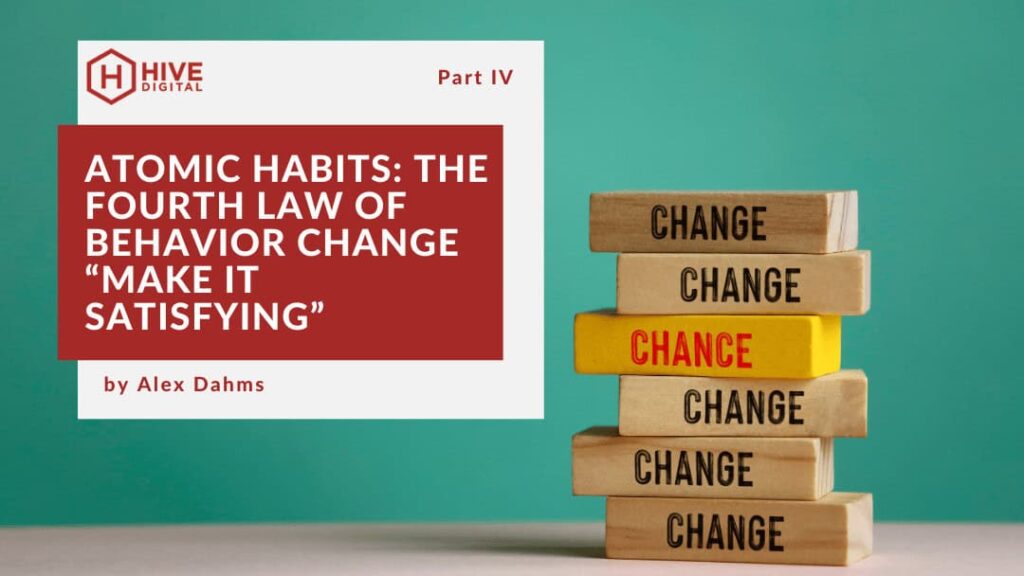Last time, we went over Clear’s third law of behavior change: Make It Easy, and all of the chapters that define it. We’ve now arrived at the part of the book that focuses on the fourth and final Law of Behavior Change: Make It Satisfying. This part of the book starts with the chapter titled The Cardinal Rule of Behavior Change.
The Cardinal Rule of Behavior Change
This chapter opens with the story of Stephen Luby, a health worker who traveled to the city Karachi in Pakistan during the late 1990s. Karachi was one of the most populous cities in the world at the time (over nine million people), but unfortunately was also one of the most unsanitary.
A whopping 60% of the population lived in squatter settlements and slums, living among trash, dirty water, mosquitos, etc. There was also a lack of waste removal, no electricity grid, few clean water supplies, and other compounding issues. The combination of these problems led to widespread illness and disease.
Luby and his team came to notice that the vast majority of the population weren’t washing their hands, and the ones who were washing them did so with an ineffective technique. After asking around about this situation, Luby and team discovered that the population was aware of how important it was to wash their hands, but they simply weren’t doing it.
- Luby and his researchers decided to supply the population with a premium soap called Safeguard, which made the act of washing their hands much more enjoyable as it was a brand they all loved. Within months, they saw a rapid decline in diseases: the rate of diarrhea fell by 52%, pneumonia by 48%, and impetigo by 35%.
- Clear goes on and mentions the terms immediate-return environment and delayed-return environment. Essentially, these two types of environments are talking about one of immediate and delayed rewards. He uses animals on an African savannah as an example of those living in an immediate-return environment, while modern day humans live in one of delayed-return.
- The human brain spent the majority of its evolution adapting to an immediate-return environment, e.g. our ancestors often placed their focus on immediate concerns, like where the next meal will come from or seeking safe shelter from wild threats. These days, we can see how certain bad habits can form from the manipulation of these immediate-rewards, like smoking to relieve stress/addiction and eating junk food because it tastes great at the moment. The consequences to these two habits are delayed, so basically our brains don’t really care… unless we make them.
- Clear suggests we can manipulate this programming by setting up immediate rewards systems for good habits that normally have a delayed one. He gives an example of opening a savings account called “Leather Jacket,” and getting out of the bad habit of impulsive purchases by donating the cost of a “passed up” purchase into this account (…though, is a leather jacket itself not this type of purchase? I guess it may depend upon the person).
- He gives various other examples of creating these baby-step rewards to string you along to a delayed one. This is essentially a strategy to make progress towards a long-term goal feel more rewarding along the way.
I thought the opening hand-washing study in this chapter was interesting, as were the other examples, but to be frank I thought it was overall a bit long-winded in that the whole chapter is essentially saying “be cool with delayed gratification.” I think he’s right with what he’s saying, as I’ve used similar methods to stop smoking and cut down on drinking in my own life (i.e. I essentially felt pride, or a reward, in the act of refusing a craving, and that made it easier to stick to it), but I’m not sure if a whole chapter was necessary to say “delayed gratification is a thing and you should take pride in every instance you don’t take part in a bad habit.”
How to Stick with Good Habits Every Day
Chapter 16 is titled How to Stick with Good Habits Every Day, and Clear opens the chapter with the story of Trent Dyrsmid, who was a young stockbroker back in 1993 and had a system to track how many sales calls he’d make in a day. This system consisted of two jars, one filled with 120 paper clips, and Dyrsmid would simply move one paper clip over from the full jar to the other every time he made a sales call. He would keep calling until all 120 paper clips had moved from the starting jar to the finishing one, and within eighteen months Dyrsmid was bringing in $5 million to the firm, which was traditionally a slower-paced firm due to its suburban location.
- Clear refers to this as the “Paper Clip Method,” which is simply one example of what is called Habit Tracking in this chapter. He provides several other examples of tracking habits, like marking X’s on a calendar every time you successfully complete a habit and creating a “streak” that you don’t want to break.
- The middle-part of this chapter is Clear describing the various factors that make Habit Tracking so appealing to us. He goes over different benefits, like how obvious you can make this type of tracking, the feeling of progress it provides, and ultimately the satisfaction you feel from performing the habit itself and “checking it off” for the day.
- He acknowledges that Habit Tracking can feel like a deterrent at times, since it feels like you are adding another habit on top of another, i.e. Habit Tracking itself becomes an “extra” habit. It may feel like you are wasting time on tracking when you could be doing other things, like… other good habits. He offers a few different suggestions to make this tracking easier, like automating it or to limit Habit Tracking to your most important habits.
- In the next section, Clear talks about how to recover your habits when you inevitably miss them, whether it is due to an emergency, a move, etc. He sets a rule for himself; never miss twice. He says missing twice is the “start of a new habit,” and it’s a bad one. He emphasizes the importance of picking the habit back up quickly if you have to miss it.
- He ends the chapter by touching upon the importance of Habit Tracking again, and how it can support/motivate good habits, but advises us not to lose sight of the habit itself. In other words, don’t focus on the tracking and the numbers; focus on the satisfaction of performing and completing the habit.
I think this is a great chapter by Clear, stressing the importance of tracking your habits while also acknowledging that it can be a little annoying to do so. I think he’s pretty much correct on everything throughout; if you track your good habits in some way, you’re definitely more likely to stick with them. You will also feel worse for missing a day or ending a “streak” you had going, so it further reinforces you to stick with em.
How an Accountability Partner Can Change Everything
This chapter starts with the story of an ex-WWII fighter pilot named Roger Fisher. He turned his focus to negotiation and conflict management after his active military service, attending Harvard Law School and founding the Harvard Negotiation Project, and eventually worked with different countries on various types of diplomatic compromises. However, he eventually came to notice that any sitting President had access to nuclear launch codes that they could utilize on a whim, potentially killing millions without realizing the gravity of what it means to actually take a life.
He suggested that a volunteer would keep the nuclear codes on their person in a capsule, but they’d also carry a knife. If the president wanted to launch a nuclear warhead, they would be first required to kill this volunteer to obtain them, so that they’d experience what it would be like to take an innocent’s life. When Pentagon officials heard of this idea they said “Having to kill someone would distort the President’s judgment. He might never push the button.”
- I’m going to guess that they never actually implemented this suggestion, but Clear references this idea to demonstrate the inversion of the 4th Law of Behavior Change, which now reads make it immediately unsatisfying. Essentially, Clear is making the point that psychologically, we have a tendency to avoid unpleasant stimuli and pain, and this can be used to help us stick with good habits and drop bad ones.
- Laws and regulations that involve various types of punishments are a few of the examples Clears refers to, but one of the more interesting ones involves a colleague of his named Bryan Harris. Bryan wanted to lose weight, so he created an official contract with specific goal points: the first phase stated that he needed to go back to a strict, “slow-carb” diet in Q1, in Q2 he was to start a strict macronutrient tracking program, etc. The relevant point here are the punishments he set for himself; Bryan wrote down on this contract that if he failed on these items, he would be forced to dress “too formally” six out of seven days in the week, and would pay his trainer $200.
- This is where the term accountability partner is mentioned. Bryan signed this contract with his wife and trainer, who were his accountability partners. As you can infer from the name, these are other people that will hold you accountable to good habits you want to maintain, and having accountability partners will greatly increase your odds of sticking to these good habits.
- Clear suggests that you can even automate this process and he refers to Thomas Frank, an entrepreneur from Colorado that set up his Twitter to tweet “It’s 6:10 and I’m not up because I’m lazy! Reply to this for $5 via PayPal (limit 5), assuming my alarm didn’t malfunction.” He set this up because he wanted to maintain waking up at 5:55 every morning, and Twitter is acting as his accountability partner (I think?).
So, anyone who has taken an introductory psychology class will be familiar with the idea of “positive punishment,” which is essentially what this entire chapter is talking about and is surprising to me that this term is not mentioned once throughout. Regardless, I think Clear is right that this can be an effective way to stick with good habits and drop bad ones, if there’s an unpleasant punishment involved.
The punishment has to be significant to actually alter your behavior though, which Clear acknowledges in this chapter. I think there is potential difficulty in coming up with and spending time creating a punishment strong enough to alter your behavior in a positive way, but that time spent may be worth it for people who need a strong deterrent to reinforce good behavior and discourage bad ones.
The Four Laws of Behavior Change and You
Overall I feel like the four laws of behavior change make a lot of sense on paper (literally). As I read through this book, it’s hard not to feel motivated to start taking on good habits and getting rid of your bad ones because Clear makes it seem so easy.
For me personally, the biggest change in my perspective was not keeping my eyes on the goal of any good habit, but rather finding enjoyment in the habit itself. The example of someone getting motivated to exercise because they want a certain body type is the most comparable one, because you will easily get discouraged if you are only exercising to get a six pack or something similar. When you realize that you aren’t getting one in a week, it’s easy to start slipping from a good fitness habit, so what has to happen is to find enjoyment in the act of exercising itself.
There are plenty of other valuable lessons and insights teeming in each chapter of this book, and though Clear makes similar points from time to time, I consider it an invaluable tool for someone looking to change their habits for the better and ultimately improve their quality of life.










